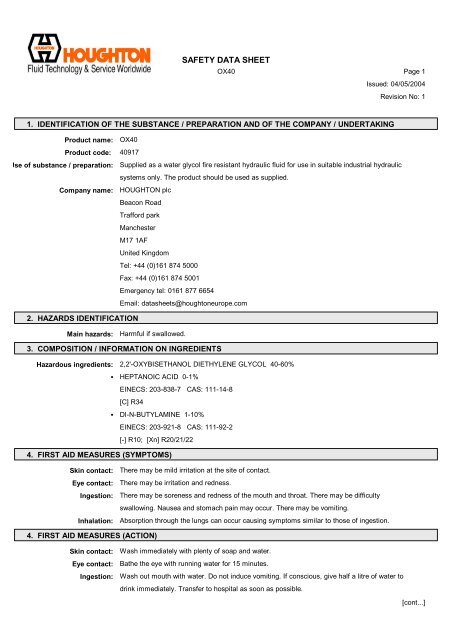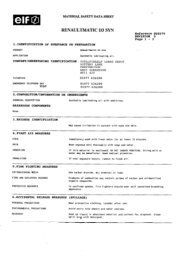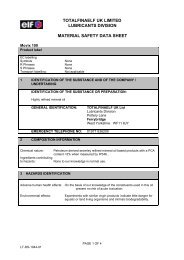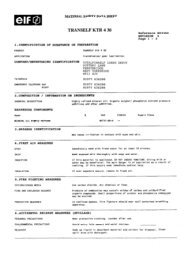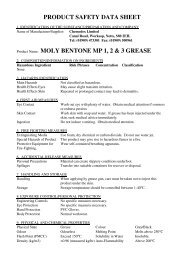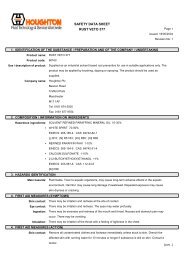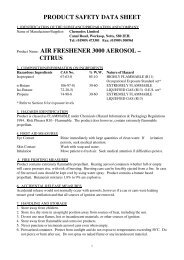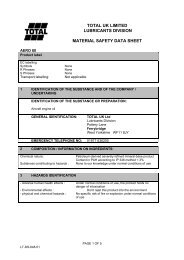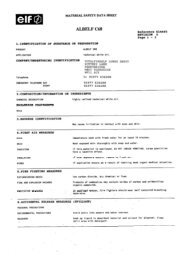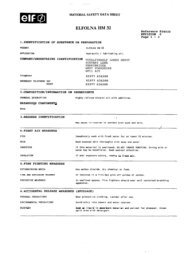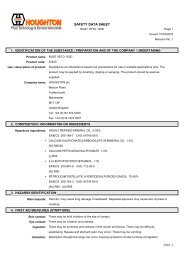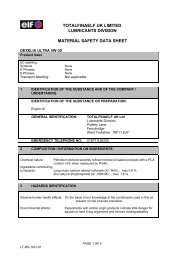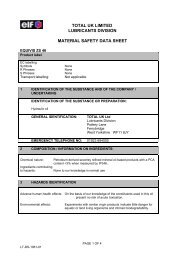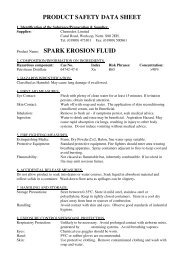SAFETY DATA SHEET
SAFETY DATA SHEET
SAFETY DATA SHEET
Create successful ePaper yourself
Turn your PDF publications into a flip-book with our unique Google optimized e-Paper software.
<strong>SAFETY</strong> <strong>DATA</strong> <strong>SHEET</strong><br />
OX40 Page 1<br />
Issued: 04/05/2004<br />
Revision No: 1<br />
1. IDENTIFICATION OF THE SUBSTANCE / PREPARATION AND OF THE COMPANY / UNDERTAKING<br />
Product name: OX40<br />
Product code: 40917<br />
Use of substance / preparation: Supplied as a water glycol fire resistant hydraulic fluid for use in suitable industrial hydraulic<br />
systems only. The product should be used as supplied.<br />
Company name: HOUGHTON plc<br />
Beacon Road<br />
Trafford park<br />
Manchester<br />
M17 1AF<br />
United Kingdom<br />
Tel: +44 (0)161 874 5000<br />
Fax: +44 (0)161 874 5001<br />
Emergency tel: 0161 877 6654<br />
Email: datasheets@houghtoneurope.com<br />
2. HAZARDS IDENTIFICATION<br />
Main hazards:<br />
Harmful if swallowed.<br />
3. COMPOSITION / INFORMATION ON INGREDIENTS<br />
Hazardous ingredients: 2,2'-OXYBISETHANOL DIETHYLENE GLYCOL 40-60%<br />
• HEPTANOIC ACID 0-1%<br />
EINECS: 203-838-7 CAS: 111-14-8<br />
[C] R34<br />
• DI-N-BUTYLAMINE 1-10%<br />
EINECS: 203-921-8 CAS: 111-92-2<br />
[-] R10; [Xn] R20/21/22<br />
4. FIRST AID MEASURES (SYMPTOMS)<br />
Skin contact:<br />
Eye contact:<br />
Ingestion:<br />
Inhalation:<br />
There may be mild irritation at the site of contact.<br />
There may be irritation and redness.<br />
There may be soreness and redness of the mouth and throat. There may be difficulty<br />
swallowing. Nausea and stomach pain may occur. There may be vomiting.<br />
Absorption through the lungs can occur causing symptoms similar to those of ingestion.<br />
4. FIRST AID MEASURES (ACTION)<br />
Skin contact:<br />
Eye contact:<br />
Ingestion:<br />
Wash immediately with plenty of soap and water.<br />
Bathe the eye with running water for 15 minutes.<br />
Wash out mouth with water. Do not induce vomiting. If conscious, give half a litre of water to<br />
drink immediately. Transfer to hospital as soon as possible.<br />
[cont...]
Issued: 04/05/2004<br />
<strong>SAFETY</strong> <strong>DATA</strong> <strong>SHEET</strong><br />
OX40 Page 2<br />
Inhalation:<br />
Remove casualty from exposure ensuring one's own safety whilst doing so. Consult a doctor.<br />
5. FIRE-FIGHTING MEASURES<br />
Extinguishing media:<br />
Exposure hazards:<br />
Protection of fire-fighters:<br />
Suitable extinguishing media for the surrounding fire should be used. Use water spray to cool<br />
containers.<br />
In combustion emits toxic fumes.<br />
Wear self-contained breathing apparatus. Wear protective clothing to prevent contact with skin<br />
and eyes.<br />
6. ACCIDENTAL RELEASE MEASURES<br />
Personal precautions:<br />
Environmental precautions:<br />
Clean-up procedures:<br />
Refer to section 8 of SDS for personal protection details. Mark out the contaminated area with<br />
signs and prevent access to unauthorised personnel. Turn leaking containers leak-side up to<br />
prevent the escape of liquid.<br />
Do not discharge into drains or rivers. Contain the spillage using bunding.<br />
Absorb into dry earth or sand. Transfer to a closable, labelled salvage container for disposal by<br />
an appropriate method.<br />
7. HANDLING AND STORAGE<br />
Handling requirements:<br />
Storage conditions:<br />
Suitable packaging:<br />
Provide suitable mechanical equipment for the safe handling of drums. Handle and open<br />
container with care. Avoid direct contact with the substance. Avoid the formation or spread of<br />
mists in the air.<br />
Store inside in cool ventilated area. Keep container tightly closed.<br />
Must only be kept in original packaging.<br />
8. EXPOSURE CONTROLS / PERSONAL PROTECTION<br />
Respiratory protection:<br />
Hand protection:<br />
Eye protection:<br />
Skin protection:<br />
Respiratory protection not required.<br />
Protective gloves.<br />
Safety glasses. Ensure eye bath is to hand.<br />
Protective clothing.<br />
9. PHYSICAL AND CHEMICAL PROPERTIES<br />
State: Liquid<br />
Colour: Green fluorescent<br />
Odour: Mild<br />
Evaporation rate: Slow<br />
Solubility in water: Soluble<br />
Viscosity value: 46cSt@40C<br />
Boiling point/range°C: >100<br />
Melting point/range°C: 100<br />
Vapour pressure: < Water<br />
[cont...]
Issued: 04/05/2004<br />
<strong>SAFETY</strong> <strong>DATA</strong> <strong>SHEET</strong><br />
OX40 Page 3<br />
Relative density:<br />
pH:<br />
1.09@15.5C<br />
9.5-conc<br />
10. STABILITY AND REACTIVITY<br />
Stability:<br />
Conditions to avoid:<br />
Materials to avoid:<br />
Haz. decomp. products:<br />
Stable under normal conditions.<br />
Heat.<br />
Strong oxidising agents. Strong acids.<br />
In combustion emits toxic fumes.<br />
11. TOXICOLOGICAL INFORMATION<br />
Hazardous ingredients: 2,2'-OXYBISETHANOL DIETHYLENE GLYCOL<br />
IVN RAT LD50 6565 mg/kg<br />
ORL MUS LD50 23700 mg/kg<br />
ORL RAT LD50 12565 mg/kg<br />
• HEPTANOIC ACID<br />
IVN MUS LD50 1200 mg/kg<br />
ORL MUS LD50 6400 mg/kg<br />
ORL RAT LD50 7 gm/kg<br />
• DI-N-BUTYLAMINE<br />
ORL MUS LD50 290 mg/kg<br />
ORL RAT LD50 189 mg/kg<br />
SCU RAT LD50 494 mg/kg<br />
Routes of exposure: Refer to section 4 of SDS for routes of exposure and corresponding symptoms.<br />
12. ECOLOGICAL INFORMATION<br />
Mobility:<br />
Persistence and degradability:<br />
Bioaccumulative potential:<br />
Other adverse effects:<br />
Readily absorbed into soil.<br />
Biodegradable.<br />
No bioaccumulation potential.<br />
Negligible ecotoxicity.<br />
13. DISPOSAL CONSIDERATIONS<br />
Disposal operations:<br />
Disposal of packaging:<br />
NB:<br />
Unused material: The product can be burnt under controlled conditions or removed by<br />
approved waste contractors.<br />
Used material: The product can be burnt under controlled conditions, recycled by competent<br />
companies or removed by approved waste contractors.<br />
IBC's have a refundable deposit paid on them and should be returned. 205 litre unlined steel<br />
drums also carry a deposit but can be returned for recycling. All other packaging should be<br />
disposed of in a manner acceptable to the authorities.<br />
The user's attention is drawn to the possible existence of regional or national regulations<br />
regarding disposal.<br />
[cont...]
Issued: 04/05/2004<br />
<strong>SAFETY</strong> <strong>DATA</strong> <strong>SHEET</strong><br />
OX40 Page 4<br />
14. TRANSPORT INFORMATION<br />
ADR / RID<br />
UN no:<br />
Not Classified.<br />
IMDG / IMO<br />
UN no:<br />
Not Classified.<br />
IATA / ICAO<br />
UN no:<br />
Not Classified.<br />
15. REGULATORY INFORMATION<br />
Hazard symbols:<br />
Harmful.<br />
Risk phrases:<br />
Safety phrases:<br />
Haz. ingredients (label):<br />
Note:<br />
R22: Harmful if swallowed.<br />
S36/39: Wear suitable protective clothing and eye / face protection.<br />
2,2'-OXYBISETHANOL DIETHYLENE GLYCOL<br />
The regulatory information given above only indicates the principal regulations specifically<br />
applicable to the product described in the safety data sheet. The user's attention is drawn to<br />
the possible existence of additional provisions which complete these regulations. Refer to all<br />
applicable national, international and local regulations or provisions.<br />
16. OTHER INFORMATION<br />
Other information:<br />
Risk phrases used in s.3:<br />
Legal disclaimer:<br />
The classification detailed on this Safety Data Sheet refer to the neat material only. Dilution of<br />
the product may reduce the classification.<br />
This safety data sheet conforms to 2001/58/EEC.<br />
Acts of Parliament: The Health and Safety at Work etc. Act 1974. Environment Protection Act<br />
1990. Statutory Instruments: Control of Substances Hazardous to Health Regulations 2002.<br />
Chemicals (Hazard Information and Packaging) Regulations 2002.<br />
R34: Causes burns.<br />
R10: Flammable.<br />
R20/21/22: Harmful by inhalation, in contact with skin and if swallowed.<br />
The above information is believed to be correct but does not purport to be all inclusive and shall<br />
be used only as a guide. This company shall not be held liable for any damage resulting from<br />
handling or from contact with the above product.<br />
[final page]


